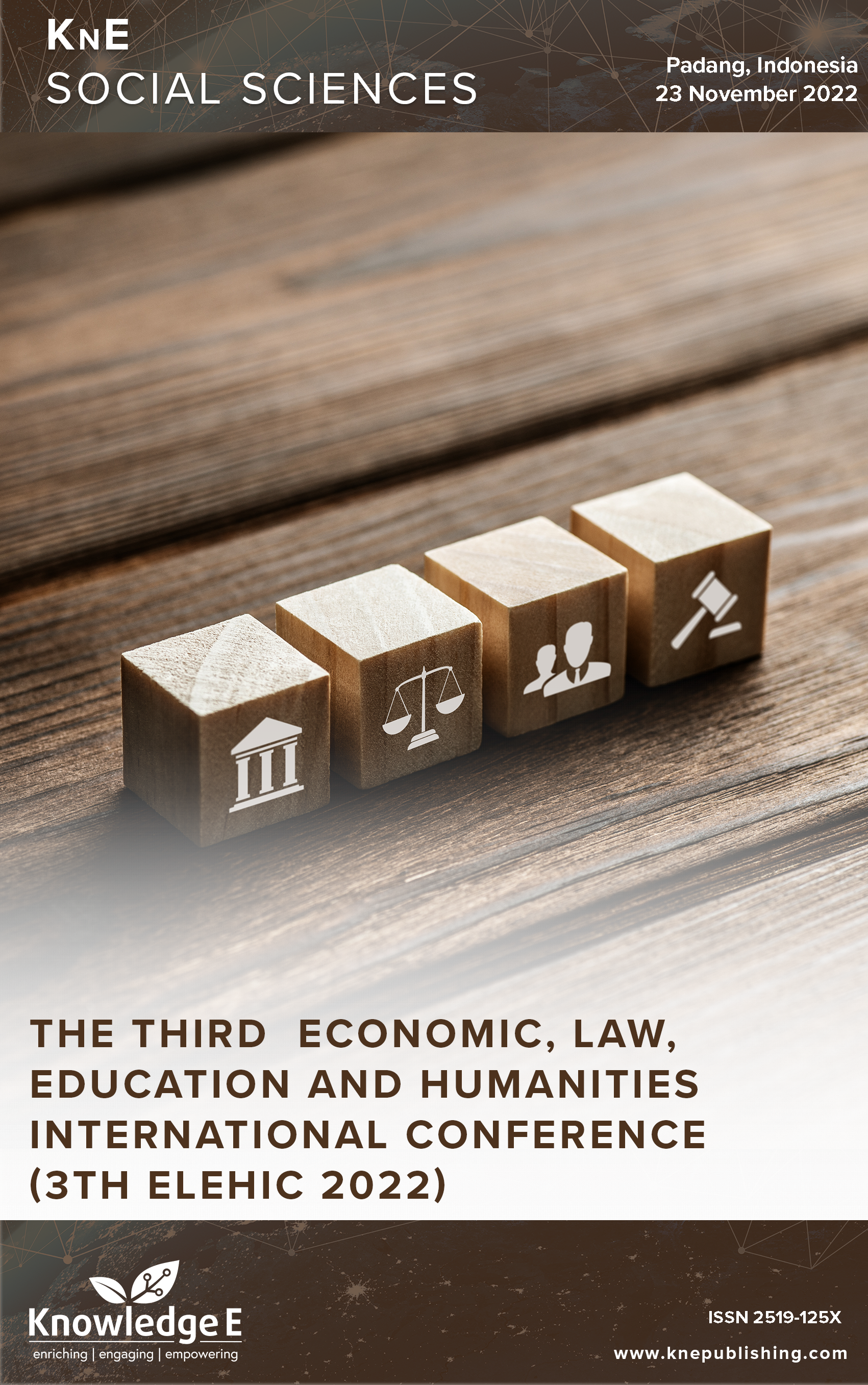Using Video in Role Playing Technique to Improve the Elementary
DOI:
https://doi.org/10.18502/kss.v8i13.13737Abstract
Speaking is the earliest skill among other language skills acquired by children and serves as the medium most frequently used in communication. Nevertheless, speaking becomes a difficult skill when performed in public, especially for elementary school. This study aims at describing how the use of video as the media in role playing in teaching speaking to elementary school students can improve their ability in speaking. This is a qualitative study using classroom action research as the design. The subject was the elementary school students at SDI Khaira Ummah Padang, West Sumatra, Indonesia. The selected video was entitled —As a Result of Telling Lies which was played before the students were asked to speak. The data were the students’ oral expression ability collected using tests, interviews, observation and documentation. The results of data analysis show that the students’ speaking ability improves in every cycle.
Keywords: Videos, role playing, technique in teaching speaking, elementary school students
References
[2] Al Hosni, S. (2014). Speaking difficulties encountered by young EFL learners. International Journal on Studies in English Language and Literature (IJSELL), 2(6), 22-30.
[3] Anil, B. (2017). Applying innovative teaching methods in a second language classroom. International Journal of Research in English Education, 2(2), 1-9.
[4] Arsyad, A. (2011). Media pembelajaran. Rajawali Press: Jakarta.
[5] Barr, M. (2018). Student attitudes to games-based skills development: Learning from video games in higher education. Computers in Human Behavior, 80(2018), 283-294.
[6] Behtash, E. Z. Saed, A., and Behtash, P. Z. (2017). The effect of role-playing tasks on the speaking ability of Iranian preintermediate ESP learners. Iranian Journal of English for Academic Purposes, 6(2), 23- 32.
[7] Czarniawska, B. (2004). Narratives in social science research. Introducing qualitative methods. Sage: London, UK.
[8] Celik, O. and Yavuz, F. (2015). The relationship between speaking grades and listening grades of university level preparatory students. Procedia-Social and Behavioral Sciences, 197(2015), 2137-2140.
[9] Denzin, N. K. and Lincoln, Y. S. (Eds.). (2018). The SAGE handbook of qualitative research (5th Edition). SAGE Publications: Thousand Oaks, CA.
[10] Elaldi, S. and Yerliyurt, N. S. (2017). The efficacy of drama in field experience: A qualitative study using Maxqda. Journal of Education and Learning, 6(1), 10-26.
[11] Gholami, R., Noordin, N., and Mustapha, G. (2013). Investigating EFL students’ EAP needs on productive skills in Malaysian universities. Pertanika J. Soc. Sci. & Hum., 21(3), 995 − 1017.
[12] Harris, D. P. (1969). Testing English as a second language. McGraw-Hill: New York.
[13] Holt, L. C. and Kysilka, M. (2006). Instructional patterns: Strategies for maximizing student learning. Sage: Thousand Oaks, CA.
[14] Idrissova, M., Smagulova, B., and Tussupbekova, M. (2015). Improving Listening and Speaking Skills in Mixed Level Groups (on the Material of New English File). Procedia - Social and Behavioral Sciences, 199(2015), 276-284.
[15] Krebt, D. M. (2017). The effectiveness of role play techniques in teaching speaking for EFL college students. Journal of Language Teaching and Research, 8(5), 863-870.
[16] Leong, L-M. and Ahmadi, S. M. (2017). An analysis of factors influencing learners’ English speaking skill. International Journal of Research in English Education, 2(1), 34-41.
[17] Lillard, A. S. (2013). Playful learning and Montessori education. NAMTA Journal, 38(2), 137 − 174.
[18] Lillard, A. S., Lerner, M. D., Hopkins, E. J., Dore, R. A., Smith, E. D., and Palmquist, C. M. (2013). The impact of pretend play on children’s development: a review of the evidence. Psychological Bulletin, 139(1), 1–34.
[19] Miles, M. B. and Huberman, A. M. (1994). Qualitative data analysis: A methods source book. Sage: Los Angeles.
[20] Moon, K. and Reifel, S. (2008). Play and literacy learning in a diverse language pre-kindergarten. Contemporary Issues in Early Childhood, 9(1), 49-65.
[21] Naz, F. and Murad, H. S. (2017). Innovative teaching has a positive impact on the performance of diverse students. SAGE Open, October-December 2017, 1-8.
[22] Outeiral, A. M. C. (2014). Assessment of young language learners: Using rubrics to bridge the gap between praxis and curriculum. Bellaterra Journal of Teaching & Learning Language & Literature, 7(1), 52-77.
[23] Rahmadevi, Y. and Rosa, R. N. (2012). Using Everyday Life Posters in Teaching Speaking to Elementary School Students. Journal of English Language Teaching, 1(1), 182-188.
[24] Rayhan, J. M. (2014). The impact of using role play techniques on improving pupils’ speaking skill for primary school. Journal of the College of Basic Education, 15(2), 516–530.
[25] Riyana, C. (2007). Pedoman pengembangan media video. P3AI UPI: Jakarta.
[26] Rojas, M. A. and Villafuerte, J. (2018). The influence of implementing role-play as an educational technique on EFL speaking development. Theory and Practice in Language Studies, 8(7), 726-732.
[27] Rusman. (2010). Model-model pembelajaran mengembangkan profesionalisme guru. Raja Grafindo Persada: Jakarta.
[28] Santrock, J. W. (2016). A topical approach to life-span development (8th Edition). McGraw-Hill Companies: New York.
[29] Setyowati, R. D. (2010). Peningkatan kualitas penghayatan tokoh pada pembelajaran apresiasi drama melalui metode bermain peran pada siswa kelas XI IPS 1 SMA Negeri 1 Kartasura tahun pelajaran 2009/2010 (Unpublished thesis). Fakultas Keguruan dan Ilmu Pendidikan Universitas Sebelas Maret Surakarta: Surakarta.
[30] Shapiro, S. and Leopold, L. (2012). A critical role for role-playing pedagogy. TESL Canada Journal, 29(2), 120-130.
[31] Sriyati, S., Mukhaiyar, M., and Rosa, R. N. (2019). The effect of using insert strategy and motivation on the reading comprehension of the second grade students of SMPN 11 Sijunjung West Sumatera. International Journal of Civil Engineering and Technology (IJCIET), 10(1), 1359-1368.
[32] Tavil, Z. M. (2010). Integrating listening and speaking skills to facilitate English language learners’ communicative competence. Procedia Social and Behavioral Sciences, 9(2010), 765–770.
[33] Tuzlukova, V., Al Busaidi, S., and Burns, S. L. (2017). Critical thinking in the language classroom: Teacher beliefs and methods. Pertanika J. Soc. Sci. & Hum., 25(2), 615- 634.
[34] Valette, R. (1977). Modern language testing. Brace Jovanovich Inc.: New York.

